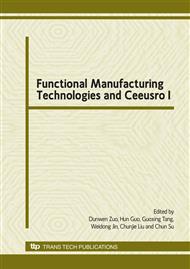p.191
p.197
p.202
p.206
p.212
p.216
p.220
p.225
p.230
Machining Mechanism of Abrasive Water Jet on Ceramics
Abstract:
Engineering ceramics feature resistance to high temperature, corrosion, wear and hot impact. However, it is difficult to machine this material in conventional machining methods because of its high hardness and brittleness as well as inconductivity, thus restricting its application area. In recent years, more and more importance has been attached to the new machining method of engineering ceramics, i.e. abrasive water-jet. Feature high efficiency and low cost, the method can be used to process the products of complex shape. However, abrasive water-jet machining of advanced ceramics is a very complex process. The effect of machining on brittle materials, and advanced ceramic materials in particular, have not yet been very well understood. The present research investigates the effect of abrasive water-jet machining on ceramics. The study will increase the general understanding of the machining phenomena for more successful application of abrasive water-jet machining on brittle materials.
Info:
Periodical:
Pages:
212-215
Citation:
Online since:
January 2010
Authors:
Keywords:
Price:
Сopyright:
© 2010 Trans Tech Publications Ltd. All Rights Reserved
Share:
Citation:


